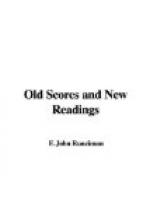ITALIAN OPERA, DEAD AND DYING
All art forms are conventions, and all conventions appear ridiculous when they are superseded by new ones. The old Italian opera form is laughed at to-day as an absurdity by Wagnerians, who see nothing absurd in a many-legged monster with a donkey’s head uttering deep bass curses through a speaking-trumpet; and perhaps to-morrow the Wagnerian music-drama and the many-legged monsters will be laughed at by the apostles of a new and equally absurd convention. It is absolutely the first condition of the existence of an art that one shall be prepared to tolerate things ludicrously unlike anything to be found in real life; and when (for instance) you have swallowed the camel of allowing the heroes and heroines to sing their woes at all, it is a little foolish to strain at the gnat of permitting them to sing in this rather than in that way, when both ways are alike preposterous. It is not, therefore, on the score of its inherent absurdity that I should throw brickbats at Italian opera, any more than with the female dress of to-day before my eyes I should insist that the women who wore the fashions of ten years ago were only fit to be incarcerated in a lunatic asylum; knowing, as I do, that the dress of ten years ago was not—and could not be—more absurd than the dress of to-day. The only reasonable objection that can be brought against Italian opera is that when it is sincere it offers what no one wants, and that when it tries to offer what everyone wants it is not sincere. I cannot quite understand what this means, but will endeavour to explain.




